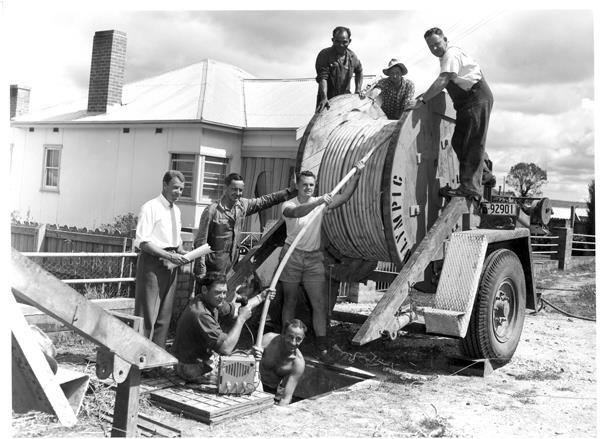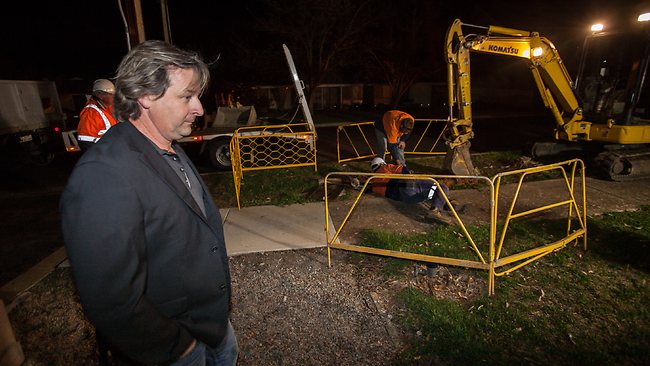
Telco e-Bulletin 2013 - #19
- CWU welcomes Telstra re-think on Operations job cuts.
- Telstra IT jobs continue to go off-shore.
- Telstra’s changing research focus brings more job losses.
- Optus mobile outsourcing faces hurdles.
- Telstra steps up use of GPS for workforce tracking.
- October is PDRP month.
- Workers have win on penalty rates.
- 50th reunion for Sydney-Melbourne cable team.
1. CWU welcomes Telstra re-think on Operations job cuts
Telstra will not go ahead with all of the redundancies initially flagged as arising out of the Operating Model Review in Operations – at least for the time being.
Last month Telstra announced an estimated reduction of 1100 positions from Operations over this financial year, with the first round of cuts affecting 360 positions, 92 of them held by agency staff.
But while the reduction in agency positions is still going ahead, nearly half of the cuts to internal staff are now being put on hold.

We also argued that no employee should be made redundant in an area where contractors were still being engaged.
Telstra has now advised the CWU that of the 293 proposed reductions in Customer Service Delivery (201 Telstra, 92 agency staff) only 153 will proceed. The agency cuts will go ahead but 140 Telstra positions, including some 65 design jobs, will be retained.
In Networks Delivery, where 30 reductions were proposed, only 17 will proceed while in Networks Media 24 of the original 26 positions will still be declared redundant.
The CWU does not want to see any of the planned 1100 redundancies proceed. But we do welcome Telstra’s willingness in this instance to reconsider its initial proposal after input from the union. In our view, such initiatives are too often driven by immediate cost pressures to the neglect of the bigger strategic picture.
2. Telstra IT jobs continue to go off-shore
While the recent reorganisation of Telstra Operations has not involved any off-shoring to date, the process continues in other sections of the business.
Telstra has advised the CWU that it proposes to reduce staff numbers within IT Service Desk and Sensis Desktop Support, with 22 roles (including 2 vacancies) being sent off-shore and 6 new roles being created.
The proposal represents a continuation of moves begun In June 2013 when Telstra’s IT Operations partnered with external vendor, TATA Consulting Services (TCS), to deliver Telstra’s Level 1 IT Service Desk support functions. Telstra says it now proposes to give both its own and Sensis’ Level 1 and Level 2 Service Desk functions to TATA.

As usual, Telstra argues that such off-shoring allows it more “flexibility” in dealing with fluctuations in demand than can be provided locally. The same argument was put in relation to off-shoring of work from Network Assisted Services (NAS).
In other words, off-shoring provides Telstra with access to a large pool of readily available and relatively cheap labour that can be summoned up when necessary and disposed of when not.
The only problem for Telstra with this strategy is growing customer resistance to having their queries dealt with from the other side of the globe, as any talk-back radio discussion on the subject quickly reveals. That is why highly customer focussed telcos like Macquarie Telecom have brought all their customer care in-house.
Once again, though, it seems that the short-term cost-cutting mentality is ruling the day.
Meanwhile the CWU has asked for more information about the data on which Telstra’s demand projections are based, particularly in relation to Sensis traffic.
3. Telstra’s changing research focus brings more job losses
A proposed reorganisation of Telstra’s Chief Technology and Innovation Office (CTO&I) sheds further light on the company’s thinking about its future shape and direction. It also means yet more redundancies.
The CWU has been notified of a restructure of the unit which will result in net reduction of 9 positions, with 29 existing roles going and 20 new ones being created. Employees affected by the changes will have first option on the 20 new roles with other CTO&I staff then able to apply.
Telstra proposes to combine the current functions of the User Experience team with the proof of concepts function under the Apps and Platform team. It will also create a new team, Programme Management and Business Development.
According to Telstra, the aim of the restructure is to align work on emerging technology options more closely with the company’s overall commercial needs and strategy. As its focus moves from its traditional network business to the provision of more software-defined services, it is to be expected the role of its technical experts will also change.
It is less clear why there should be fewer of them, though. And while it is intended that CTO&I will play a central role in driving innovation throughout the company, the requirement that it be increasingly “commercial and pragmatic” in its outlook surely has its dangers.
The history of telecoms is full of examples of costly mistakes based on quick-fixes and off-the-shelf “solutions”. Telstra needs to retain the capability for in-depth analysis of emerging technologies and their applicability under Australian conditions – geographic, demographic and regulatory, not only commercial.
4. Optus mobile outsourcing faces hurdles
Optus’ plans to outsource its mobile deployment functions are progressing slowly, at least when it comes to staff transfers.
Earlier this year, Optus informed the CWU that it was proceeding with Operation Cortez which would see future work on Optus’ mobile networks performed by a third party. A number of companies including Visionstream, Kordia and Silcar all expressed interest in the opportunity.

Under the proposed “transfer of business” to Visionstream, Optus employees who were selected to work for the new employer would retain their current conditions while those who were not “picked” would be redeployed or made redundant.
But what if the selected employees don’t want to transfer? The present NBN-related instability in the telecommunications construction industry has some Optus employees worried. Some 250 jobs were recently lost, for instance, when Silcar was effectively absorbed into Thiess, so security of future employment in this sector is a real concern.
The CWU is engaged in discussions with Optus about how best to protect the interests of all the Optus employees potentially affected by this proposal, including any who may choose not to transfer to Visionstream.
Given that radiocommunications skills are in short supply, it is surely in the interests of both Optus and Visionstream to ensure that all employees involved regard the process and its outcomes as fair and equitable.
5. Telstra steps up use of GPS for workforce tracking
Telstra intends to enhance its use of GPS technology to allow closer tracking of its field workforce.
The company has advised the CWU of two initiatives relating to Communication Technician (CT) activity: Whole of Day and Click Locate.
The Whole of Day programme involves the coordination of existing CT location information with Connect ticket-of-work data. Telstra intends to monitor the position of a CT at the time of “onsite” and “complete” reports. If the CT is not within a certain distance of the customer premises and the relevant exchange during these times, the ticket of work will be regarded as non-compliant.

Telstra will focus on “End of Day” procedures in the first instance with start and middle of day compliance procedures rolled out in full by the end of the year.
Click Locate is a dispatch tool that will allow Telstra to see the location of CTs in real time on a map. It will alert the dispatcher (through changing from green to red) if the CT has taken longer than the scheduled time at any one location.
Click Locate will be trialled in Vic/Tas in November.
Telstra says both these initiatives are designed to increase work “efficiency” by allowing a more rational allocation of jobs and reducing travelling time. In the CWU’s experience, however, such goals often prove illusory.
The CWU will be monitoring the impacts of these initiatives closely and seeks feedback from members about their implementation. Members should report, in particular, any use of data gathered through these programmes for performance assessment and/or disciplinary action.
There is little doubt that many managers will see these GPS tools as a way of exerting performance and perhaps disciplinary pressures on CTs. The CWU has already received some reports from members to this effect and will be pursuing this issue with Telstra as a matter of urgency.
6. October is PDRP month
October is the month for performance reviews in Telstra.
All Telstra employees are put through the Performance Development Review Process (PDRP). And although it is only Job Family workers whose pay levels are determined primarily through the review, no-one wants an unfavourable assessment from their team leader/manager.
CWU members who receive an assessment which they think is inaccurate or unfair should seek advice from the union. We can discuss your options and help you develop an appeal against your rating using the Internal Resolution Process (IRP).
7. Workers have win on penalty rates
Low-paid hospitality workers were the winners from a Fair Work Commission decision to reject an employers’ bid to scrap penalty rates.
The Restaurant and Caterers’ Association has applied to the Commission to have penalty rates on Saturdays and Sundays struck out of the industry award.
But the Commission rejected the bid, saying that the RCA had not backed up its claims that reducing penalty rates would benefit the community by increasing productivity or creating jobs.
ACTU president Ged Kearney said the decision recognised the importance of penalty rates in compensating workers for working unsociable hours.
“Workers in hospitality should be relieved that the Fair Work Commission has seen reason and rejected this attempt to cut their wages,” she said.
She warned however that business was likely to ratchet up its campaign to reduce penalty rates now that it had a sympathetic government in Canberra.
"There is still no long-term certainty that workers will keep their penalty rates, “she said. “The Coalition has refused to guarantee penalty rates in law, which means employer groups will continue to try to get rid of them as a way to cut wages."
8. 50th reunion for Sydney-Melbourne cable team
This year it will be 51 years since the Sydney-Melbourne coaxial cable link was officially opened.

The project, which linked Australia’s two largest cities and the capital, Canberra, involved laying 15,000 tonnes of cable over a 960 kilometre route including passing under 17 rivers.
It allowed direct dialling and simultaneous television broadcasts for the first time, including the live broadcast of the 5th test of the 1962-63 Ashes series to Sydney, Canberra and Melbourne - a major milestone in Australian television history.
The build involved thousands of Telstra staff, including surveyors who covered the route on foot and pegging parties who followed after them marking, out the path for the cable.
Organiser Dick Corin, one of the senior engineers on the project, said the cable was laid through some of Australia’s toughest terrain, under extreme weather conditions and used revolutionary technology that was years ahead of its time.
The cable continued in use for two decades until it was replaced by a fibre link.
As Australia embarks on another large telecoms infrastructure project, it is interesting to reflect on the achievement that the Sydney-Melbourne link represented and the conditions which underpinned its success.
Not least of those was a permanently employed, fully trained and appropriately paid workforce, seen here at work –and at leisure, probably enjoying camping party allowance.

He was digging up the NBN fibre his company had laid as a protest against delays in payments.
Policy makers take note: is this an efficient use of public monies?










